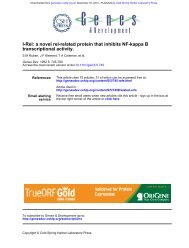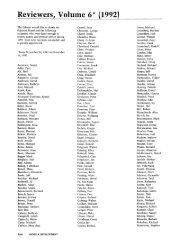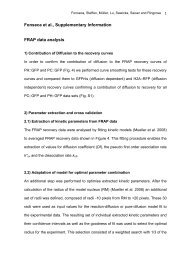Pancreatic cancers require autophagy for tumor growth - Genes ...
Pancreatic cancers require autophagy for tumor growth - Genes ...
Pancreatic cancers require autophagy for tumor growth - Genes ...
Create successful ePaper yourself
Turn your PDF publications into a flip-book with our unique Google optimized e-Paper software.
Downloaded from<br />
genesdev.cshlp.org on June 4, 2013 - Published by Cold Spring Harbor Laboratory Press<br />
intraepithelial neoplasms (PanINs) to advanced <strong>tumor</strong>s.<br />
The cleavage of the LC3 protein allows it to be lipidated<br />
and targeted to autophagic vesicles and has been used to<br />
monitor <strong>autophagy</strong> (Ketteler and Seed 2008; Sivridis et al.<br />
2010). Using an antibody specific <strong>for</strong> cleaved LC3, we<br />
analyzed a collection of 25 PanINs and 80 primary PDAC<br />
by immunohistochemistry (IHC) (Fig. 2A,B). Minimal<br />
cytoplasmic staining was observed in the normal pancreatic<br />
ductal epithelium or in low-grade PanIN-1 and most<br />
PanIN-2 (17 lesions analyzed). In contrast, all high-grade<br />
PanIN-3 and PDAC showed elevated cleaved LC3 staining,<br />
with moderate to strong staining intensity in 81% (65<br />
of 80 PDAC). The staining was frequently in a microvesicular<br />
pattern, and less frequently as large vesicles.<br />
This pattern of staining is highly suggestive of autophagosomes<br />
(Fig. 2C), a hallmark of <strong>autophagy</strong> (Mizushima<br />
et al. 2010). Comparable high levels of staining were observed<br />
in lymph node metastasis (data not shown). We<br />
also observed high levels of staining in the nerve fibers<br />
infiltrated by <strong>tumor</strong> (Fig. 2B). Importantly, as an additional<br />
control <strong>for</strong> the specificity of the staining, we ob-<br />
<strong>Pancreatic</strong> <strong>cancers</strong> <strong>require</strong> <strong>autophagy</strong><br />
Figure 1. PDAC have high levels of basal<br />
<strong>autophagy</strong>. (A) PDAC cells and controls<br />
(HPDE [immortalized normal HPDEs],<br />
MCF7 [breast cancer], and H460 [lung cancer])<br />
were infected with a retrovirus expressing<br />
GFP-LC3, grown in complete media in<br />
the presence of serum, and then fixed and<br />
analyzed by fluorescence microscopy <strong>for</strong> the<br />
presence of LC3 dots, which represent autophagic<br />
vesicles. Numerous discrete autophagic<br />
puncta were present in PDAC cells,<br />
while each of the control cell lines showed<br />
only a diffuse expression of GFP. The percentage<br />
of autophagic cells (defined as the<br />
presence of more than five foci) is shown<br />
in the adjacent histogram. The differences<br />
between all eight of the PDAC lines as<br />
compared with HPDE cells are statistically<br />
significant (P < 0.05 by the Fisher’s exact<br />
test). Bar, 20 mM. (B) PDAC cells and controls<br />
were cultured under normal <strong>growth</strong><br />
conditions, and the number of LC3 puncta<br />
per cell was determined in the absence<br />
and presence of the <strong>autophagy</strong> inhibitor<br />
CQ. As in A, note the robust increase in<br />
foci of PDAC cells versus HPDE, H460,<br />
and MCF7 (dark-gray bars). (^) Statistical<br />
significance compared with HPDE cells.<br />
Autophagic flux is elevated in PDAC, as<br />
evidenced by the increase in puncta per cell<br />
when treated with CQ (light-gray bars<br />
show increase in foci upon CQ treatment).<br />
Asterisk represents a statistically significant<br />
increase upon CQ treatment compared<br />
with untreated cells. (C) Autophagic flux in 8988T PDAC cells shown by a robust increase in LC3-II expression upon<br />
inhibition of lysosomal proteases with E64d + pepstatin A as well as CQ at various time points. (D) Long-term protein degradation was<br />
assessed in 8988T cells using a GFP-Neo fusion protein that enters the long-term protein degradation pathway. GFP expression was<br />
monitored by FACS. The left panel shows decreased GFP expression on day 1 and day 2 as compared with day 0, indicating activated<br />
<strong>autophagy</strong> under basal conditions. The right panel demonstrates that CQ, an inhibitor of <strong>autophagy</strong>, blocks the long-term protein<br />
degradation in these cells. (E) Long-term protein degradation was assessed in MCF7 cells, as in D. Note the minimal change in GFP<br />
expression, indicating low levels of basal <strong>autophagy</strong>. This is not affected by the addition of CQ.<br />
served strong LC3 staining in a microvesicular pattern in<br />
pancreatic islets (Fig. 2D), consistent with the known role<br />
of constitutive <strong>autophagy</strong> in b-cell homeostasis (Jung<br />
et al. 2008). As further evidence that <strong>autophagy</strong> was<br />
indeed activated in pancreatic primary <strong>tumor</strong>s, electron<br />
microscopy showed the presence of autophagosomes<br />
fusing to lysosomes, as well as autophagosomes fused to<br />
lysosomes (autolysosomes) (Fig. 2E). IHC analysis also<br />
revealed that levels of the essential <strong>autophagy</strong> gene ATG7<br />
(He and Klionsky, 2009) are elevated in the majority of<br />
PDAC examined (57 of 80 <strong>tumor</strong>s) (Supplemental Fig.<br />
1C). Thus, the data using human cell lines, as well as<br />
primary human <strong>tumor</strong>s, demonstrate that <strong>autophagy</strong> is<br />
up-regulated in the later stages of the progression of<br />
PanIN to PDAC.<br />
PDAC are sensitive to <strong>autophagy</strong> inhibition<br />
in vitro by CQ<br />
The prominent activation of <strong>autophagy</strong> in advanced<br />
PDAC and in PDAC cell lines grown in nutrient-rich<br />
GENES & DEVELOPMENT 719







